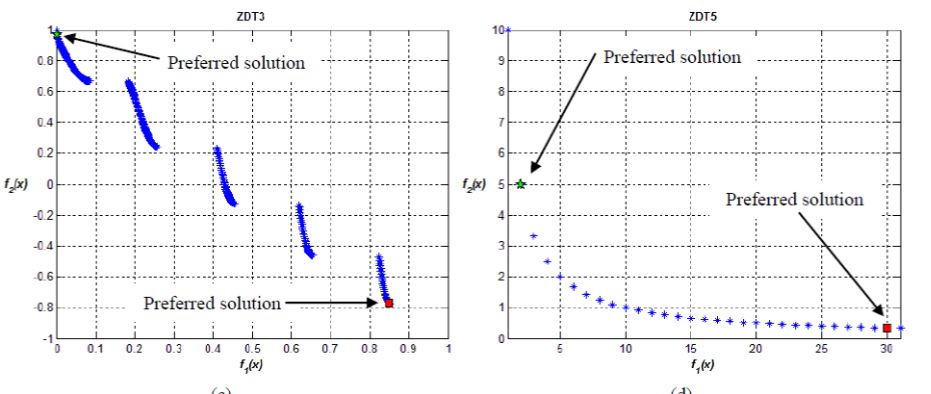A Decision Making Approach for Multi-Objective Optimization Considering A Trade-off Method
Main Article Content
Abstract
In multi-objective optimization problem, a set of optimal solutions is obtained from an optimization algorithm. There are many trade-off optimal solutions. However, in practice, a decision maker or user only needs one or very few solutions for implementation. Moreover, these solutions are difficult to determine from a set of optimal solutions of complex system. Therefore, a trade-off method for multi-objective optimization is proposed for identifying the preferred solutions according to the decision maker’s preference. The preference is expressed by using the trade-off between any two objectives where the decision maker is willing to worsen in one objective value in order to gain improvement in the other objective value. The trade-off method is demonstrated by using well-known two-objective and three-objective benchmark problems. Furthermore, a system design problem with component allocation is also considered to illustrate the applicability of the proposed method. The results show that the trade-off method can be applied for solving practical problems to identify the final solution(s) and easy to use even when the decision maker lacks some knowledge or not an expert in the problem solving. The decision maker only gives his/her preference information. Then, the corresponding optimal solutions will be obtained, accordingly.
Article Details
References
S. Sudeng and N. Wattanapongsakorn, “Post Pareto-optimal pruning algorithm for multiple objective optimization using specific extended angle dominance”, Engineering Applications of Artificial Intelligence, Volume 38, February, pp. 221-236, 2015.
T. Sooktip and N. Wattanapongsakorn, “Identifying preferred solutions for multi-objective optimization: application to capacitated vehicle routing problem”, Cluster Computing, 18(4), pp. 1435-1448, 2015.
S.-H. Baek, S.-J. Ryu and J.-H. Kim, “DMQEA-FCM: An approach for preference-based decision support”, IEEE International Conference on Fuzzy Systems, pp. 1983-1990, 2016.
K. Yang, L. Li, A. Deutz, T. Back and M. Emmerich, “Preference-based multiobjective optimization using truncated expected hypervolume improvement”, 12th International Conference on Natural Computation, Fuzzy Systems and Knowledge Discovery, pp. 276-281, 2016.
G. Yu, J. Zheng, R. Shen and M. Li, “Decomposing the user-preference in multiobjective optimization”, Soft Computing, 20 (10), pp. 4005-4021, 2016.
K. Deb, J. Sundar, N. Udaya Bhaskara Rao, and S. Chaudhuri, “Reference Point Based Multi-Objective Optimization Using Evolutionary Algorithms”, International Journal of Computational Intelligence Research, 2(3), pp. 273–286, 2006.
S. Bechikh, L. Ben Said, and K. Ghedira, “Searching for knee regions in multi-objective optimization using mobile reference points,” the 25thACM symposium on Applied Computing Conference, pp. 1118-1125, 2010.
S. Bechikh, L. Ben Said and K. Ghedira, “Searching for knee regions of the Pareto front using mobile reference points,” Soft computing-A Fution of Foundations, Methodologies and Applications, 15(9), pp. 1807-1823, 2011.
K. Deb and A. Kumar, “Light beam search based multi-objective optimization using evolutionary algorithms”, IEEE Congress on Evolutionary Computation, pp. 2125-2132, 2007.
U.K. Wickramasinghe and X. Li, “Using a distance metric to guide PSO algorithms for many-objective optimization”, the 11th Annual Genetic and Evolutionary Computation Conference, pp. 667-674, 2009.
H. Rajabalipour Cheshmehgaz, Md.N. Islam and M.I. Desa, “A polar-based guided multi-objective evolutionary algorithm to search for optimal solutions interested by decision-makers in a logistics network design problem”, Journal of Intelligent Manufacturing, 25(4), pp. 699-726, 2014.
K. Miettinen, F. Ruiz and A.P. Wierzbicki, “Introduction to Multiobjective Optimization: Interactive Approaches”, Multiobjective Optimization. Springer, Berlin, Heidelberg, pp. 27-57, 2008.
J. Branke, T. Kaußler and H. Schmeck, “Guidance in evolutionary multi-objective optimization”, Advances in Engineering Software, 32(6), pp.499-507, 2001.
S.L. Tilahun and H.C. Ong, “Fuzzy Preference of Multiple Decision-Makers in Solving Multiobjective Optimization Problems Using Genetic Algorithm”, Maejo International Journal of Science and Technology, Vol. 6, No. 2, pp. 224-237, 2012.
K. Deb, Multi-Objective Optimization Using Evolutionary Algorithms, Wiley, New York, pp. 13–14, 2008.
E. Zitzler, M. Laumanns, and L. Thiele, “SPEA2: Improving the strength pareto evolutionary algorithm for multiobjective optimization,” Evolutionary Methods for Design, Optimisation and Control with Application to Industrial Problems, pp. 95–100, 2001.
K. Deb, A. Pratab, S. Agrawal, T. Meyarivan, “A fast and elitist nondominated sorting genetic algorithm for multi-objective optimization: NSGA II”, IEEE Trans. Evol. Comput. 6, 182 -197, 2002.
Q. Zhang and H. Li, “MOEA/D: A multiobjective evolutionary algorithm based on decomposition,” IEEE Transactions on Evolutionary Computation, vol. 11, pp. 712–731, Dec. 2007.
K. Deb and A. Kumar, “Interactive evolutionary multi-objective optimization and decision-making using reference direction method”, Proceedings of the 9th annual conference on Genetic and evolutionary computation, pp. 781–788, 2007.
L. Thiele, K. Miettinen, P.J Korhonen, and J. Molina, “A preference-based evolutionary algorithm for multi-objective optimization” Evolutionary computation, 17(3), pp.411-436, 2009.
T. Sooktip, N. Wattanapongsakorn and S. Srakaew, “Non-Preference Based Pruning Algorithm for Multi-Objective Redundancy Allocation Problem”, In Information Science and Applications, Springer Berlin Heidelberg, pp. 793-800, 2015.
E. Zitzler, K. Deb and L. Thiele, “Comparison of multiobjective evolutionary algorithms: empirical results”, Evolutionary computation, 8(2), pp. 173-195, 2000.
S. Huband, P. Hingston, L. Barone, and L. While, “A review of multiobjective test problems and a scalable test problem toolkit”, IEEE Transactions on Evolutionary Computation, 10(5), pp. 477-506, 2006.
A. Coello, Carlos & Lamont, Gary & A. Van Veldhuizen, David. “MOEA Test Suites”, 175-232. 10.1007/978-0-387-36797-2_4, 1970.
D.E. Fyffe, W.W. Hines and N.K. Lee, “System reliability allocation and a computational algorithm”, IEEE Trans. Reliab. 17, pp. 74–79, 1968.
S. Kulturel-Konak,, D.W. Coit, and F. Baheranwala, “Pruned Pareto-optimal sets for the system redundancy allocation problem based on multiple prioritized objectives”, Journal of Heuristics, 14(4), pp.335, 2008.

